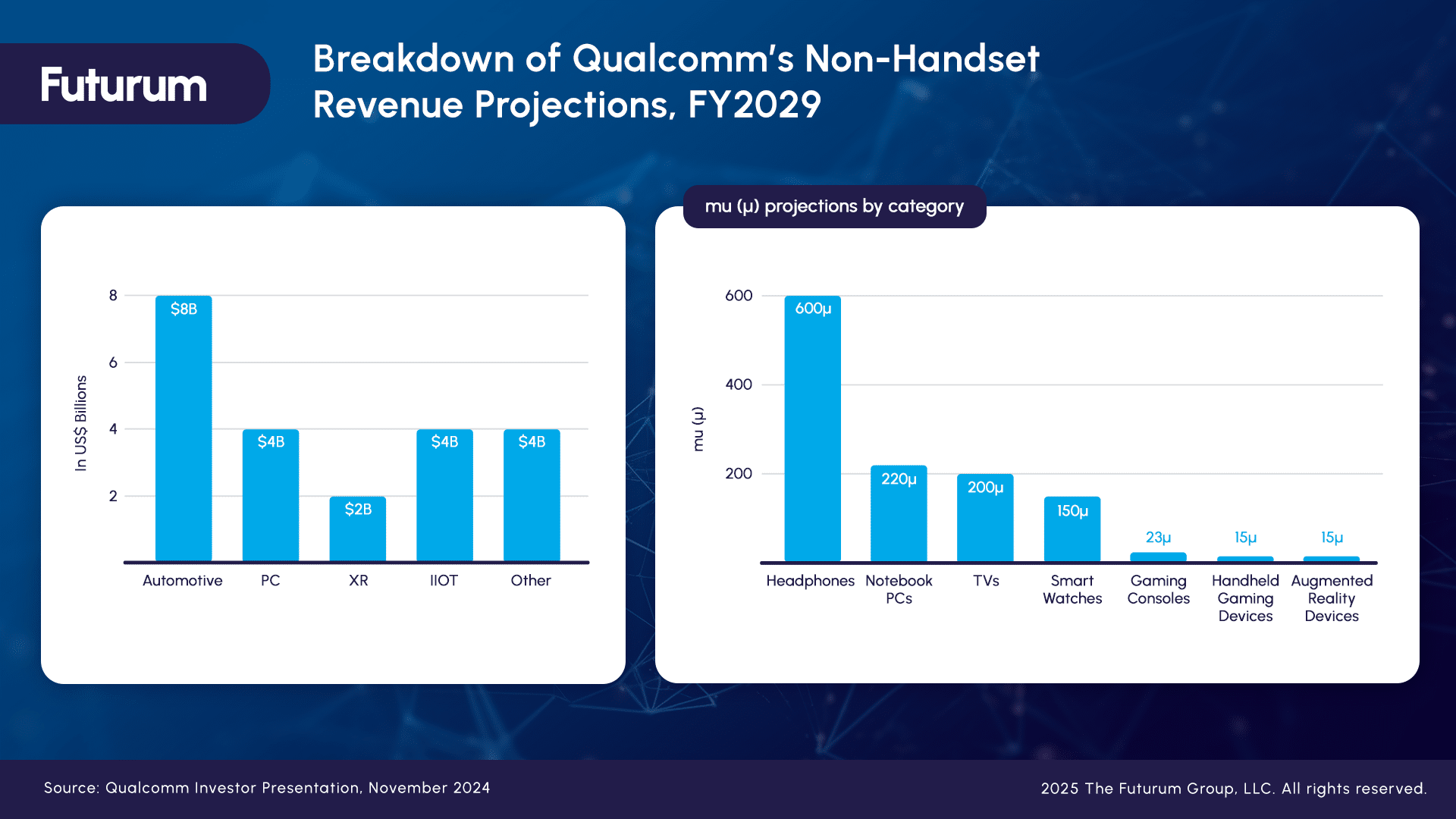Analyst(s): Olivier Blanchard
Publication Date: March 18, 2025
Apple hopes to be ready to equip all of its new iPhones with its own in-house modems in 2028, coinciding with the end of its licensing agreement with Qualcomm. The recent release of Apple’s in-house C1 modem is a critical milestone on its cellular modem roadmap and a good indicator of where Apple is in its product development timeline. As one of Qualcomm’s largest cellular modem customers, Apple’s exit from that agreement is expected to create a >$7B annual revenue hole in Qualcomm’s balance sheet. Will Qualcomm be able to mitigate this loss by 2028, and if so, how?
Key Points:
- Following the recent release of its C1 modem, Apple appears to be on track to transition away from Qualcomm’s modems in time for the expiration of its licensing agreement, which is set to end in 2027.
- Qualcomm’s annual modem revenue from sales to Apple is estimated to be somewhere between $5.7B and $5.9B, with an additional $1.6B to $1.9B from RF components and other subsystems. Apple’s complete exit from Qualcomm’s modem-RF business would, therefore, result in a $7.3B to $7.8B annual revenue shortfall for Qualcomm starting in 2028.
- Thanks to Qualcomm’s diversification efforts in recent years, however, this shortfall is already being mitigated by growth in other critical segments, primarily Automotive and IOT. Qualcomm’s automotive and IOT segments, which are on track to grow at 28.1% and 26.6% by 2028, respectively, are expected to account for 49% of total modem revenue for Qualcomm by 2030.
Overview:
Figure 1: Breakdown of Qualcomm’s Non-Handset Revenue Projections for FY2029

Apple is in the process of developing its own cellular modems, presumably in the hopes of having a full stack of in-house 5G modems to service its entire line of iPhones by 2027, when its licensing agreement with Qualcomm is set to expire.
Apple’s two primary reasons for wanting to create its own in-house line of cellular modems are (1) cost savings and (2) better control over the design of its modem-RF solutions to better integrate them into its systems. On the cost side of the equation, we estimate that Qualcomm’s modem, with memory but without RF components, accounts for roughly 6% of an iPhone’s overall component costs, or about $25 per iPhone.
To put Apple’s exit from Qualcomm’s modem business in perspective, Qualcomm’s annual modem revenue from sales to Apple is estimated to be somewhere between $5.7 and $5.9B, with an additional $1.6B to $1.9B from RF components and other subsystems. Apple’s complete exit from Qualcomm’s modem-RF business should therefore result in a $7.3B to $7.8B annual revenue shortfall for Qualcomm, which will fully materialize sometime between 2027 and 2028.
However, Qualcomm’s diversification efforts in recent years should help the company more than make up for the loss through growth in other critical segments, primarily Automotive and IoT.
Qualcomm’s automotive and IOT segments, which are on track to grow at 28.1% and 26.6% by 2028, respectively, are expected to account for 49% of total modem revenue for Qualcomm by the time Apple completes its exit.
If Qualcomm’s modem business were limited to handsets, the loss of Apple’s business would be far more difficult for Qualcomm to absorb. Thanks to Qualcomm’s maturing diversification strategy, however, its situation is looking a lot more encouraging.
Cases in point: Qualcomm’s Automotive and IoT modem segments are currently on track to grow at an average of 28% and 27%, respectively, by 2028. Based on current numbers, this would translate to somewhere north of $13B in additional revenue by 2028. Since a >$13B boost in annual revenue should be more than enough to absorb the annual $7B from Apple, Qualcomm looks well positioned to, again, successfully emerge from yet another disruption to its modem business.
More to the point, Qualcomm’s diversification strategy has positioned the company for growth despite the loss of customers as important as Huawei and Apple.
- Based on Qualcomm’s latest Investor Day (November 2024) projections, the company expects their ratio of revenue from handsets versus revenue from Automotive and IOT to shift from 75% (handsets): 25% (A/IOT) in 2024 to 50% (handsets): 50% (A/IOT) in 2030.
- Qualcomm expects to grow annual revenue from Automotive and IOT from $8.3B in FY24 to $22B by 2030 (a 22% CAGR). (Individually, we expect the Automotive business to fall in the neighborhood of 30% CAGR and IOT around 14% CAGR for the next 5 years.)
In other words, Qualcomm’s diversified growth across these specific verticals is credibly expected to significantly exceed the revenue scale of modem-only handset customers well into the era of 6G.
The full report is available via subscription to Futurum Intelligence’s AI Devices IQ service—click here for inquiry and access.
Futurum clients can read more in the AI Devices Intelligence Portal, and nonclients can learn more here: AI Devices Intelligence Practice.
About the Futurum AI Devices Practice
The Futurum AI Devices Practice provides actionable, objective insights for market leaders and their teams so they can respond to emerging opportunities and innovate. Public access to our coverage can be seen here. Follow news and updates from the Futurum Practice on LinkedIn and X. Visit the Futurum Newsroom for more information and insights.
Author Information
Research Director Olivier Blanchard covers edge semiconductors and intelligent AI-capable devices for Futurum. In addition to having co-authored several books about digital transformation and AI with Futurum Group CEO Daniel Newman, Blanchard brings considerable experience demystifying new and emerging technologies, advising clients on how best to future-proof their organizations, and helping maximize the positive impacts of technology disruption while mitigating their potentially negative effects. Follow his extended analysis on X and LinkedIn.
